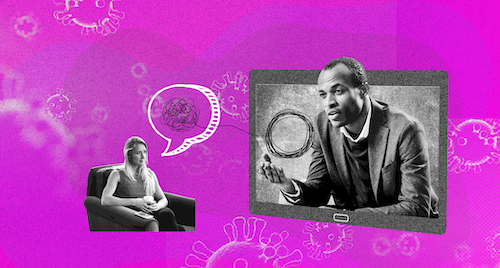
Many things changed with the onset of the pandemic with COVID-19 concerns altering our daily routines and behavior.
Although the global Coronavirus lockdown and present pandemic situation is completely unwanted, some of those alterations have been positive. Lecturer Brian Dates, who’s worked as a community health psychologist for nearly 30 years, says one area that shows promising change is mental telehealth services.
Telehealth technology and its use are not new, but Dates says widespread adoption among healthcare professionals and patients beyond simple telephone correspondence has been relatively slow — until COVID-19.
He’s currently working with several Wayne County health network community service organizations to see what effect the shift from a face-to-face mental health service to a virtual one has had in behavioral health therapy, focusing on the past six months.
“From what I’ve seen, this is the first major study of telehealth effectiveness with community health services. That’s probably because the widespread use is so new. Since the pandemic, many states have made legislative or regulatory changes to loosen these restrictions and increase telemental health access as well as reimbursement,” Dates says. The change in regulation was spurred by the March CARES Act. Prior to it, telehealth services through community agencies could only take place in designated locations with the use of synchronous video technology; the bill allowed patients to receive services at home and included funding that expanded coverage for telehealth services in Medicare.
“As we transitioned into different phases of the pandemic, we looked at how people handled transitioning to the telemental health format,” he says. ”There is still research to do, but we are seeing that telemental health as a delivery mechanism is working for people.”
Dates presented his research — The Effect of Transitioning to Telemental Health Service Delivery on Service Array and Experience of Intervention: A Study of the Response to SARS-CoV-II in the Detroit-Wayne Community Mental Health System — at the College of Arts, Sciences, & Letters Research Slam Friday.
Dates’ presentation shared how he, along with other community health researchers, sifted through services-related data from October 2019 through September 2020. There are nearly 12,000 consumers, or clients, in the dataset. All people live in Detroit and its metro areas, but there’s a wide variety of representation in ages, gender, sex, ethnicities and more.
The study breaks the months into time periods — pre-pandemic, pandemic/CARES Act implementation, and the months that followed — and compares data like the average number of hours of therapy received, the number of time clients had contact with a service agency, amount of hours per client, and more.
“It’s a large study. And so far the data is very promising. Through our data, we expect to show that the number of canceled appointments and the number of no-shows have decreased. People are getting access to care where they are. They don’t have to worry about public transit schedules or whether or not it’s a safe time to walk. They are getting services right into their homes,” he says. “It’s also more effective on the therapist’s end. Before, the therapist had to drive to agencies, offices or homes. Now they have more time to meet with clients.”
Dates says they are finishing up the quantitative side of the study, and will shift to focusing on the qualitative side of the study. Client and provider statements were taken during those same time periods.
Living through a pandemic is a traumatic experience, and Dates is pleased to see that the less vulnerable people were not left out through healthcare expansions that allowed them to access mental health services. And he expects the research will show — through its comprehensive design and encouraging outcome measures — the importance of continuing the telemental health delivery.





